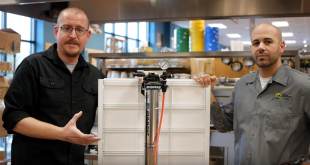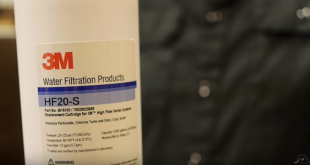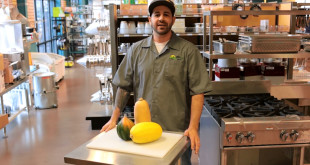The difference between average coffee and great coffee can be truly amazing. Freshly roasted, fresh ground beans that are brewed correctly can elevate a cup of coffee from being a standard morning-starter to a truly amazing drink. Though this may take a little more time than pushing the start button on Mr. Coffee, tailoring your grind and brewing method to the coffee you’re using can make all the difference. Tamas Christman, founder and president of Dragonfly Coffee Roasters in Boulder, Colorado explains a couple ways to ensure you brew a perfect cup of coffee.
Learn more about Dragonfly Coffee Roasters here!
View our selection of coffee products here!
Before taking action from the content or resources published here, we request that you visit and review our terms of use.
Transcript:
What I’d like to talk about today is how to brew sort of the ultimate cup of coffee. My name is Tamas Christman. I am the founder and President of Dragonfly Coffee Roasters. My history is that I have been passionate about coffee my entire life. I’ve actually been roasting coffee since I was eight years old. My formal background is in chemical engineering and computer science. For me it’s been in part a lot of chemistry and artistry and kind of combining them to yield what I think is an exceptional cup of coffee. There’s all sorts of different ways to make the perfect cup of coffee. With that we have to factor in how we’re going to grind our coffee because the coffee will be ground sort of tailored to each individual extraction to optimize the desirable flavor and minimize the undesirable characteristics.
Starting with our French press, that is of a style of brewing that’s known as steeping. Basically we have coffee that’s in constant contact with water. We have to be more careful with over-extraction. With the French press the ratio of coffee to water we want to use is for the standard one liter French press we want to add about an inch or two and a half to three ounces of, of course, the ground coffee. With the French press you always want to lean to more coffee because of the grounds than less coffee. The ideal ratio is going to be around two ounces of ground coffee coarsely ground to the one liter of water. Essentially we want to let the coffee bloom for between 30 seconds to a minute. Slowly infuse the water into the grounds saturating all the grounds.
What we see here is the interaction of CO2 and water. As the water starts to absorb into the coffee ground, the CO2 that’s coming out of the coffee from the roasting process interacts and makes it bubble. Now that we’ve allowed the grounds to bloom as we start to bring in more water we’ll see that the color changes and the crust kind of expands. We see a lot of the residual CO2 start to boil, to bubble out, to sort of push up. This is a great time to get your nose down in there. Allow it to extract for a total of about eight to nine minutes. Then slowly plunge down. Ultimately it shouldn’t be hard to press down. If the saturation level of the water and the grinds is accurate, then you should be able to just slowly depress the plunger without a lot of resistance.
Once you’re fully plunged, it’s ready to pour. Excellent. Now let’s talk a little bit about how to make an exceptional cup of coffee using a standard single-cup pull-over. This is probably one of my favorite ways to make coffee. This is how I make coffee every day in the morning. With the pull-over, it’s a totally different extraction method than the French press. With the French press, we had the water and the coffee hanging out together and extracting the grind [inaudible 03:14]. What we want to do here is we have our cup and our standard Melitta dry filter. It’s just a recycled, unbleached filter. You’ll see it’s a little moist. What I like to do is once I get the filter placed in the pull-over, I will do a quick little purge of the filter. I sort of pre-wet the filter.
That just dampens it, sets it up against the side of the ceramic but then also pushes any particulate of dust or any kind of flavor that may be in there is usually washed out by that. Once we have our filter pre-wet then for a 12-ounce pour I use three scoops which these scoops are one tablespoon. That’s 21 grams. Once we’ve reached boiling, we’re going to let the water come slightly off of boil just for a few seconds. Then it gets to be 201, 202. We want to essentially just let a little bit of water incorporate with the coffee. Allow it to bloom, Interact it with the CO2. This coffee was roasted yesterday. There’s a lot more aggressive blooming and interaction with this CO2 than that if we let this sit.
Now water temperature is also a very important factor when it comes to whether it will be a French press or pull-over. We want optimally somewhere our water to be within the range of 198 to 202 Fahrenheit. I find that the best temperature is right at about 200 degrees Fahrenheit. Once we have established a good bloom, we just slowly and consistently agitate the coffee. As long as there’s a constant flow of motion in the coffee, then you’re good to go. If you let it sit for too long what will happen is that there will be a damming at the bottom of the pour-over of the sedimentation of the coffee. That’s going to slow the time that it’s taking for the water to drain under the base of the filter. That’s going to increase the extraction, thus leading to it being over-extracted cup.
What we’re looking at right here is the actual diameter of the stream coming out as we’re finishing the pour-over. It should throughout the duration of the pour somewhere between a spaghetti noodle and a linguine. If it starts to just drip, drip drip, that means that you’re getting damming in the basin of the pour-over. You’re going to end up over-extracting the coffee. Really we want a nice steady stream all the way through. Then once it’s finished pouring, we should have a really nice cup. I’m Tamas Christman with Dragonfly Coffee Roasters. I want to thank you for watching my brewing guide sort of to the exceptional cup of coffee. Remember, coffee is the most complex beverage that we consume on a day-to-day basis. It has over 850 chemical compounds that comprise the aroma and the flavor.
There is no right or wrong answer to how you brew your coffee. I encourage you to experiment. Take something that you’ve learned today and turn your next morning cup into an exceptional experience.
 Corner Booth Blog | TundraFMP Restaurant Supply, News & Equipment Blog
Corner Booth Blog | TundraFMP Restaurant Supply, News & Equipment Blog



